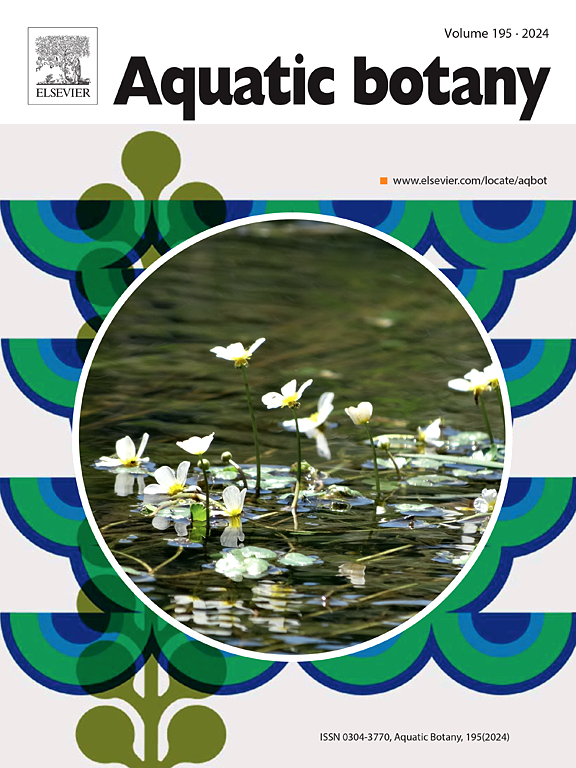Intra and inter specific variation of propagule settings of the family Rhizophoraceae in the Sundarbans mangrove forest
IF 2.6
4区 生物学
Q2 MARINE & FRESHWATER BIOLOGY
引用次数: 0
Abstract
The Sundarbans mangrove forest in Bangladesh is home to the Rhizophoraceae family, which includes at least 7 species. Understanding the factors influencing mangrove species regeneration in specific areas, such as propagule dispersal, predation, and soil conditions, is crucial for comprehending how these populations establish and grow successfully in changing environments. However, there is limited research on the reproductive phenology of Rhizophoraceae in the Sundarbans. Our research was primarily focused on analyzing and comparing the reproductive phenology of three specific species, Bruguiera sexangula (Lour.) Poir., Rhizophora mucronata Lam., and Kandelia candel (L.) Druce within this diverse ecosystem. We studied the flowering pattern, conversion rate, and growth stages of the reproductive organs of these three species. Both inter- and intra-specific variations in propagule mass and size were also investigated. Our findings revealed that the flowers of these species were present for almost half of the year, with a monthly flowering peak occurring primarily in April and May. The propagule of R. mucronata (60.3 cm) was the longest in size which significantly varied from those of K. candel and B. sexangula. While the diameter and weight of the propagules of B. sexangula and K. candel were similar, they were significantly different from those of R. mucronata. In terms of length and surface area, there were significant variations among the propagules of the studied species. The mean surface area of the propagule was 359.7 cm2 in R. mucronata, 232.8 cm2 in K. candel, and 62.2 cm2 in B. sexangula. Regarding litterfall contribution, reproductive organ production in B. sexangula accounted for 29.1 %, in K.candel it was 37.7 %, and in R.mucronata it was 34.6 %. Our findings suggest that the production of reproductive organs in this mangrove forest is influenced by climatic factors as well as the specific adaptive characteristics of each species rather than solely dependent on the size of the reproductive organs.
孙德尔本斯红树林根瘤菌科繁殖体设置的内部和内部特异性变异
孟加拉国的孙德尔本斯红树林是红树科植物的家园,其中至少有 7 个物种。了解影响特定地区红树林物种再生的因素(如繁殖体传播、捕食和土壤条件),对于理解这些种群如何在不断变化的环境中成功建立和生长至关重要。然而,有关孙德尔本斯地区根瘤菌科植物繁殖物候学的研究十分有限。我们的研究主要集中在分析和比较三个特定物种,即 Bruguiera sexangula (Lour.) Poir.、Rhizophora mucronata Lam 和 Kandelia candel (L.) Druce 在这一多样化生态系统中的生殖物候学。我们研究了这三个物种的开花模式、转化率和生殖器官的生长阶段。我们还研究了繁殖体质量和大小在种间和种内的变化。我们的研究结果表明,这些物种的花期几乎占全年的一半,每月的开花高峰主要出现在四月和五月。R. mucronata 的繁殖体(60.3 厘米)最长,与 K. candel 和 B. sexangula 的繁殖体相比差异显著。虽然 B. sexangula 和 K. candel 的繁殖体直径和重量相似,但它们与 R. mucronata 的繁殖体有显著差异。在长度和表面积方面,研究物种的繁殖体之间存在显著差异。R. mucronata的繁殖体平均表面积为359.7平方厘米,K. candel为232.8平方厘米,B. sexangula为62.2平方厘米。在落叶贡献率方面,B. sexangula 的生殖器官产量占 29.1%,K.candel 占 37.7%,R.mucronata 占 34.6%。我们的研究结果表明,这片红树林的生殖器官产量受气候因素和每个物种的具体适应特征的影响,而不仅仅取决于生殖器官的大小。
本文章由计算机程序翻译,如有差异,请以英文原文为准。
求助全文
约1分钟内获得全文
求助全文
来源期刊

Aquatic Botany
生物-海洋与淡水生物学
CiteScore
3.80
自引率
5.60%
发文量
70
审稿时长
6 months
期刊介绍:
Aquatic Botany offers a platform for papers relevant to a broad international readership on fundamental and applied aspects of marine and freshwater macroscopic plants in a context of ecology or environmental biology. This includes molecular, biochemical and physiological aspects of macroscopic aquatic plants as well as the classification, structure, function, dynamics and ecological interactions in plant-dominated aquatic communities and ecosystems. It is an outlet for papers dealing with research on the consequences of disturbance and stressors (e.g. environmental fluctuations and climate change, pollution, grazing and pathogens), use and management of aquatic plants (plant production and decomposition, commercial harvest, plant control) and the conservation of aquatic plant communities (breeding, transplantation and restoration). Specialized publications on certain rare taxa or papers on aquatic macroscopic plants from under-represented regions in the world can also find their place, subject to editor evaluation. Studies on fungi or microalgae will remain outside the scope of Aquatic Botany.
 求助内容:
求助内容: 应助结果提醒方式:
应助结果提醒方式:


